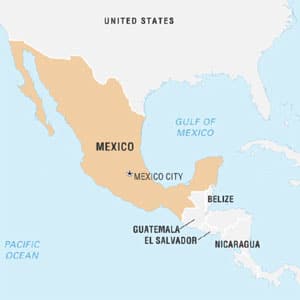International student recruitment in Mexico: Demand for language study still leading the way
- Demand for English-language education remains strong in Mexico, and it is now the seventh-largest ELT market globally (up from twelfth in 2019)
- Research firm BONARD found that in 2023, “Mexico [as a language market] achieved a 45% y-o-y growth and reached a 135% recovery rate [from the pandemic]”
- Mexican demand for higher education abroad has been growing as well, but the market is cost-sensitive and this, plus the relatively good availability of quality post-secondary options at home, has moderated outbound numbers
Fast Facts
Population: 130.7 million
Youth population: 25% of Mexicans are aged 15-29, but the population is ageing
Youth unemployment rate: 6.1% (2023 estimate)
GDP: US$1.8 trillion (2023)
Main economic sectors: Food and beverages, tobacco, chemicals, iron and steel, petroleum, mining, textiles, clothing, motor vehicles, consumer durables, tourism.
Geography: Mexico is part of North America, south of the US.
Official language: Spanish
Language of instruction: Spanish, but English as a medium of instruction is increasingly being adopted by many Mexican universities
Tertiary enrolment rate: 46%, compared to a world average of 55%
Literacy rate: 95%
English-language proficiency: Low, according to the EF English Proficiency Index (87th out of 116 countries ranked)
Religion: Christian and predominantly Roman Catholic
Main student cities: Mexico City, Puebla, Guadalajara, Monterrey, and another 11 cities have populations exceeding 1 million.
Economy: The upper-middle-income-classed economy grew by 1.6% in 2024 – a slowdown from the previous two years. The new Trump administration’s policy direction may cause significant economic turmoil in Mexico this year, not least because of the US President’s tariff threats and intent to revise North American trade policies.

The most recent UNESCO data (2022) counts 36,922 Mexican students abroad in higher education, and this number has been rising in tandem with the growing number of college-aged Mexicans (4 million today compared with under 2 million in 2000).
That said, more than 4 in 10 (45%) Mexican youth aged 15–24 are not enrolled in education, hampering economic development in the country. This statistic reflects incredibly unequal access to education in Mexico depending on region and class. Only 24% of the Mexican population has a higher education degree, compared with the OECD average of 44%.
Mexicans tend to choose the US, Spain, Germany, Canada, France, Australia, and the UK for higher education studies. Though the number of students leaving Mexico for higher education is growing, the number going abroad for English-language training is much larger. Mexican ELT enrolments in foreign institutions grew by 35% between 2016 and 2020, and in 2023, Mexico became one of the top 10 ELT markets in the world according to research firm BONARD.
Top destinations for Mexican students
The number of Mexican enrolments in top destinations has not been growing as robustly as enrolments from many other top source countries. Opportunities are there, however, for institutions that can accommodate Mexicans’ price sensitivity and for alternative destinations with relatively more open student visa settings.
Here is a summary of growth trends and declines in major destinations for Mexican students:
Canada: 16,980 Mexicans in study-permit-required programmes of over 6 months in 2023 (+14%) and an additional 14,000 in short-term language programmes (that do not require a study permit). Mexico is the largest market for Canada’s French-language programmes, and year-over-year growth from Mexico for these programmes was 59% in 2023, higher than the 13% growth recorded by English-language providers. The Canadian government says, “There are over 300 MOUs between Canadian and Mexican higher education institutions as well as a number of MOUs between Canadian education associations and Mexican government bodies.”
United States: 15,400 in higher education in 2023 (+7%), and 1,750 in Intensive English Programs (IEPs), down 16%. The number of Mexican students in undergraduate programmes in the US is almost double the number in graduate programmes.
Spain: 5,540 in 2022/23 in higher education, up 13%.
Australia: 3,620 Mexicans in 2024, which is stable from 2023. While Brazil and Colombia are in the top 10 markets for Australia’s English-language teaching sector (ELICOS), Mexico is not.
Germany: 3,600 in 2023, and the German government “there are almost 500 cooperation agreements between German and Mexican universities.”
France: France is the fifth most popular destination for Mexican students, according to the government (without citing enrolment figures). An official statement says, “progress is being made in French-language teaching based on agreements signed with 12 Mexican states via the work of the French Institute of Latin America (IFAL) based in Mexico City, as well as a network of 32 Alliances Françaises.”
United Kingdom: There were about 1,500 Mexicans in UK higher education in 2022 (-18% from 2019). Mexico is not a top 10 market for UK ELT. The UK government is exploring transnational education opportunities in Mexico, noting that the cost of studying in the UK is a major barrier for Mexican students. Though there may not be many Mexican students in the UK, academic collaboration is robust: Universities UK notes that “the UK is Mexico’s fourth most frequent collaborator globally and third in Europe (after Spain and France), with 1,528 co-authored publications by Mexico and the UK (with 10 or fewer co-authors) between 2015 and 2017. The most significant research areas are physics and astronomy, medicine, agricultural and biological science, earth and planetary sciences, biochemistry, genetics and molecular biology and engineering."
Interest is strong, but following through on study abroad plans may be weaker
A global Flywire study found that of 1,900 international students surveyed, “Mexico has the second highest percentage (vs. Peru at 73%) of students planning to study internationally (57%).” The global average was 42%. However, only 13% of those surveyed were actually studying abroad compared to a global average of 27%. Cost is the major barrier for Mexican students:
“Students from Mexico cite more sensitivity about their education payments than most other countries. 90% say they need help affording their education expenses, and 79% say the process of making tuition payments has been a significant stressor for them and their families.”
Alternative study destinations may grow more popular
Mexican students now face significant challenges in studying abroad in traditional destinations. Canada has imposed caps on international student numbers, the Trump administration is casting a suspicious eye on both Mexico and Canada, and the UK is expensive. Spain is one of the only destinations experiencing significant growth in Mexican enrolments (+13% in 2022/23).
UK educators are exploring transnational education opportunities in Mexico given the cost barrier, but even then, tuition fees may be an issue given the Mexican government’s commitment to free higher education for its citizens.
Despite challenges in 2025, Mexico remains an important source market for foreign English-language providers. BONARD notes that in 2023, “Mexico achieved a 45% y-o-y growth and reached a 135% recovery rate, becoming the seventh biggest market globally (up from twelfth in 2019)."
BONARD anticipates that because it will be harder for many language students (and not just Mexicans) to obtain visas for traditional destinations, demand will increase for Ireland, Malta, New Zealand, and South Africa. They add: “Moreover, a stronger language education provision in alternative destinations such as Dubai and intra-regional destinations – particularly within the Asia-Pacific region – is increasing competition and diverting students from traditional markets.”
For additional background, please see:
















